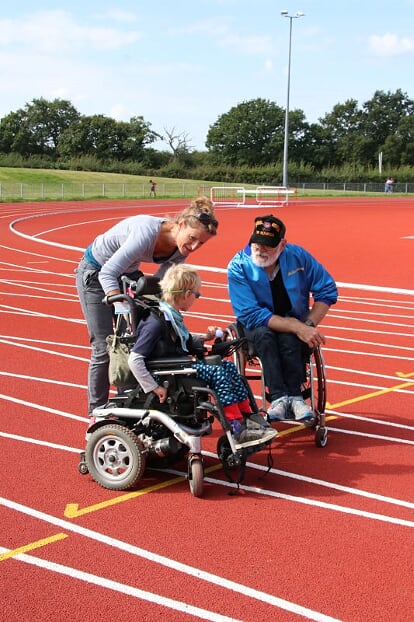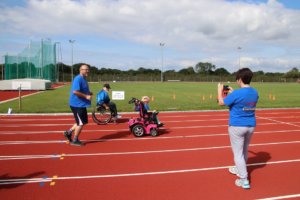21 Driving Games for Electric Wheelchair Users
When children learn to mobilise, whether on the floor, rolling, crawling or on their feet, they learn all kinds of skills including spatial awareness, negotiating obstacles, changing direction and motor planning.
If our child uses a wheelchair they may not have had the opportunity to develop these skills when they were small, so they will need to be learnt in their chair. And what better way to learn than through games!
This fabulous programme from Nicole Wilkins, a children’s Occupational Therapist, takes us through some lovely progressions and games to play as our child learns how to use an electric wheelchair.
These powered wheelchair mobility activities are suitable for children and young people with a range of abilities.
The games are written for multiple children participating, but can be easily adapted if just you and your child are taking part.

Your child needs to be given the freedom to explore & play with fun motivating activities.
Begin with one familiar assistant.
Begin on slow speed, in large open spaces that are free of obstacles (i.e. driving up to a table).
Allow your child to direct the play activity and where to drive. Only provide minimal verbal instructions.
Give your child verbal feedback on what they are doing (i.e. “you are driving in circles”).
Use functional verbal directions as many children don’t understand the words right, left, forward, reverse (i.e. “let’s play over here” or “turn this way” or “go”).
Give frequent positive feedback.
Provide your child with the appropriate level of supervision in a safe environmental setting.
Keep sessions a reasonable length for your child’s energy level. Shorter, more frequent sessions are usually best.
These powered wheelchair mobility activities are great fun!
Leader turns away from children on the opposite side of the room. The leader gives the commands “go go go” or “stop” randomly. The children drive towards the leader and whomever reaches the leader or crosses a line on the ground first gets to be the leader.
Leader plays music while the children move around. When the music stops the children have to stop. Whomever doesn’t stop is out of the game and the last person remaining gets to be the leader. A variation can be the moving monster who will eat anyone that isn’t stopped.
Leader places a sheet of bubble wrap on the ground (coloured paper may be needed underneath for greater visibility, and it should be taped to the floor/ground). Children can drive over it to hear the loud popcorn noises until all the popcorn is made and they don’t hear any more “pops.”
Tape a flashlight to the wheelchair and dim the lights. Have the children enjoy driving around shining their light on items in the large room.
Place an empty juice box on the ground and children drive over it to see who has the flattest one. Full juice boxes can be fun to squish outside.
Children line up on one end of the room/field and when you say “tortoise” they have to drive as slowly as possible and when you say “hare” they have to drive as quickly as possible.
Children line up on one side of the room/field. Yell “shark attack” and count to 10 before catching the kids who have driven to the other side.

Children can push a large therapy roll from one area to another to pretend they are a steamroller, bobcat tractor, snowplow, paddlewheel boat etc. Ensure the roll won’t get trapped under wheelchair wheels or under the footrests.
Children drive to a large therapy roll positioned vertically to knock it over, yell “timber” to pretend it’s a tree or other object they knocked over. Ensure they stop immediately afterwards to prevent it getting trapped under the wheelchair.
Avoid this activity if the child can’t differentiate between a play task and knocking real objects over.
Children push a large therapy ball or other large ball that won’t get caught under the wheelchair wheels or footrests into a goal area to score. Option would be to drive towards goal and give child a ball to throw or push into a goal.
Children can push the large therapy roll on its side or a large ball to knock over bowling pins (plastic bottles).
Tape together huge sections of cardboard to create a large tunnel the children can drive through. Hang strips of crepe paper to the far end for them to drive through the ribbons. Sound effects are fun.
Children drive to various areas in a room or in various rooms to locate other kids who are hidden.
Children can pretend they are pirates and hunt for hidden treasure around the room or in several rooms. Scavenger hunts are a fun option where children locate items on a list or that relate to a current learning theme.
Children drive through obstacle courses of varying difficulty. Design with common objects such as street chalk, skipping ropes, hose, chairs, cardboard tunnels, homemade street signs, mats, large pylons etc.
Children drive the wheelchairs from lily pad to lilypad to stay out of the water. Paper lilypads are taped to the floor. Substitute for colours, numbers, letters, pictures of animals, the child’s name etc.
Children drive beside taped paper groceries or near toy or real grocery items and collect them in on their lap, in a basket, or backpack with help if needed. Any number of items can be collected (i.e. stickers) or delivered such as letters (i.e. pretending to be a postman).
Children drive the wheelchairs onto taped paper facial features on the floor. The leader then picks it up and places it on the wall to build a funny face. Any number of items could be built such as a house, an animal, etc.
Children drive to a clothesline that has various items hanging from it and either grabs the item that is requested or stops underneath that item.
Children drive over a rubber snake, chalkline or skipping rope that is thrown in a particular location. Alternatively, the children need to drive on a pathway to avoid driving on the snakes.
Children drive around the room to locate items they’d like to wear for a costume.







